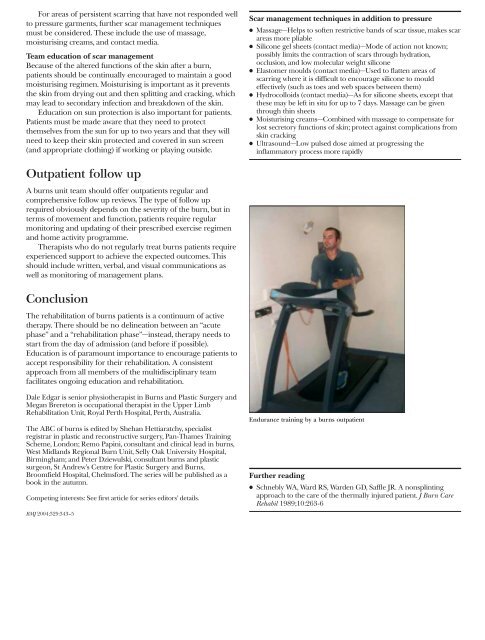ABC of Burns
You also want an ePaper? Increase the reach of your titles
YUMPU automatically turns print PDFs into web optimized ePapers that Google loves.
For areas <strong>of</strong> persistent scarring that have not responded well<br />
to pressure garments, further scar management techniques<br />
must be considered. These include the use <strong>of</strong> massage,<br />
moisturising creams, and contact media.<br />
Team education <strong>of</strong> scar management<br />
Because <strong>of</strong> the altered functions <strong>of</strong> the skin after a burn,<br />
patients should be continually encouraged to maintain a good<br />
moisturising regimen. Moisturising is important as it prevents<br />
the skin from drying out and then splitting and cracking, which<br />
may lead to secondary infection and breakdown <strong>of</strong> the skin.<br />
Education on sun protection is also important for patients.<br />
Patients must be made aware that they need to protect<br />
themselves from the sun for up to two years and that they will<br />
need to keep their skin protected and covered in sun screen<br />
(and appropriate clothing) if working or playing outside.<br />
Scar management techniques in addition to pressure<br />
x Massage—Helps to s<strong>of</strong>ten restrictive bands <strong>of</strong> scar tissue, makes scar<br />
areas more pliable<br />
x Silicone gel sheets (contact media)—Mode <strong>of</strong> action not known;<br />
possibly limits the contraction <strong>of</strong> scars through hydration,<br />
occlusion, and low molecular weight silicone<br />
x Elastomer moulds (contact media)—Used to flatten areas <strong>of</strong><br />
scarring where it is difficult to encourage silicone to mould<br />
effectively (such as toes and web spaces between them)<br />
x Hydrocolloids (contact media)—As for silicone sheets, except that<br />
these may be left in situ for up to 7 days. Massage can be given<br />
through thin sheets<br />
x Moisturising creams—Combined with massage to compensate for<br />
lost secretory functions <strong>of</strong> skin; protect against complications from<br />
skin cracking<br />
x Ultrasound—Low pulsed dose aimed at progressing the<br />
inflammatory process more rapidly<br />
Outpatient follow up<br />
A burns unit team should <strong>of</strong>fer outpatients regular and<br />
comprehensive follow up reviews. The type <strong>of</strong> follow up<br />
required obviously depends on the severity <strong>of</strong> the burn, but in<br />
terms <strong>of</strong> movement and function, patients require regular<br />
monitoring and updating <strong>of</strong> their prescribed exercise regimen<br />
and home activity programme.<br />
Therapists who do not regularly treat burns patients require<br />
experienced support to achieve the expected outcomes. This<br />
should include written, verbal, and visual communications as<br />
well as monitoring <strong>of</strong> management plans.<br />
Conclusion<br />
The rehabilitation <strong>of</strong> burns patients is a continuum <strong>of</strong> active<br />
therapy. There should be no delineation between an “acute<br />
phase” and a “rehabilitation phase”—instead, therapy needs to<br />
start from the day <strong>of</strong> admission (and before if possible).<br />
Education is <strong>of</strong> paramount importance to encourage patients to<br />
accept responsibility for their rehabilitation. A consistent<br />
approach from all members <strong>of</strong> the multidisciplinary team<br />
facilitates ongoing education and rehabilitation.<br />
Dale Edgar is senior physiotherapist in <strong>Burns</strong> and Plastic Surgery and<br />
Megan Brereton is occupational therapist in the Upper Limb<br />
Rehabilitation Unit, Royal Perth Hospital, Perth, Australia.<br />
The <strong>ABC</strong> <strong>of</strong> burns is edited by Shehan Hettiaratchy, specialist<br />
registrar in plastic and reconstructive surgery, Pan-Thames Training<br />
Scheme, London; Remo Papini, consultant and clinical lead in burns,<br />
West Midlands Regional Burn Unit, Selly Oak University Hospital,<br />
Birmingham; and Peter Dziewulski, consultant burns and plastic<br />
surgeon, St Andrew’s Centre for Plastic Surgery and <strong>Burns</strong>,<br />
Broomfield Hospital, Chelmsford. The series will be published as a<br />
book in the autumn.<br />
Competing interests: See first article for series editors’ details.<br />
BMJ 2004;329:343–5<br />
Endurance training by a burns outpatient<br />
Further reading<br />
x Schnebly WA, Ward RS, Warden GD, Saffle JR. A nonsplinting<br />
approach to the care <strong>of</strong> the thermally injured patient. J Burn Care<br />
Rehabil 1989;10:263-6



